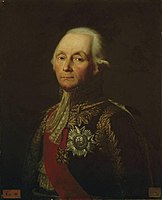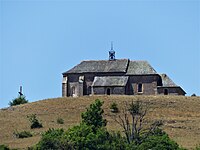Zoé Goyet
Zoé Goyet | |
|---|---|
| Born | Jeanne-Zoé Grozier de Boulieu[1] |
| Died | 8 July 1869 Chateau de Greffière (Saône-et Loire) |
| Spouse | Eugène Goyet |
Zoé Goyet (died 8 July 1869) was a French portrait painter, pastel artist, and teacher. Her works were exhibited in the Paris Salon from 1834 to 1841. She was the wife of painter Eugène Goyet and daughter-in-law of painter Jean-Baptiste Goyet.
Career
Zoé Goyet was a direct descendant of the influential Parisian art dealer and engraver Jean Mariette.[2] Her marriage to Eugène Goyet brought her into the household and atelier he shared with his father, Jean-Baptiste Goyet, at 3 Rue de l'Abbaye in Paris. All three were artists, exhibiting their works at the prestigious annual Paris Salon and exhibitions in other cities in France. Zoé exhibited portraits at the Salon from 1834 to 1839 and in 1841; she received a medal in 1837.[3] In 1838 she painted a portrait of the popular novelist Michel Masson that was widely reproduced in his books.[4]
In 1837, after the Goyets moved to 25 Rue de la Chausée-D'Antin, they set up their studios next door at number 27, where Eugène and Zoé also taught drawing and painting to female students.[5] At least one graduate of her atelier exhibited at the Paris Salon, in 1864.[6]
Eugène Goyet died in 1857. In 1859, Zoé Goyet completed her husband's final commission—of a painting of Christ at Calvary, for La chapelle Notre-Dame du Calvaire, Garbriac, Averyon, France—marking the end of over three decades in which the three Goyets played a prominent role in the world of French art.[7] Zoé died in 1869.
Gallery
-
Undated and untitled portrait, private collection.[8]
-
Portrait of François Christophe de Kellermann, Musée de l'Armée, Paris
-
Christ at Calvary, La chapelle Notre-Dame du Calvaire, Gabriac, Aveyron, France (1859)
-
La chapelle Notre-Dame du Calvaire, Gabriac, Averyon, France
References
- ^ Bénézit, Emmanuel. Dictionnaire critique et documentaire des peintres, sculpteurs, dessinateurs & graveurs de tous les temps et de tous les pays, 1924, vol. 2, p. 468.
- ^ Audiffred, Hyacinthe. "Nécrologie: Eugène Goyet", Revue des Beaux-Arts, tome 8, 1857, pp. 237-8.
- ^ Auvray, Louis. Dictionnaire général des artistes de l'École française, 1882-1885, p. 684.
- ^ Coyecque, Ernest. Collection Parent de Rosan: inventaire des estampes, tome 1, p. 424.
- ^ Le Charivari, 24 December 1837 p. 7.
- ^ Veuve Victoire-Adèle Keuler, "élève de Mme. Goyet," Explication des Ouvrages de Peinture et Dessins, Sculpture, Architecture et Gravure des Artistes Vivans, aux Palais des Élysées, 1864, p. 599.
- ^ "RESSOURCES La médiathèque numérique culturelle—Goyet". patrimoines.laregion.fr/. 23 April 2020.
- ^ If this work is authentically by Goyet, it may noted that she here signs her first name with a diaeresis (Zoë) rather than an accent aigu (Zoé), as it is uniformly found in contemporary printed sources.


![Undated and untitled portrait, private collection.[8]](http://upload.wikimedia.org/wikipedia/commons/thumb/d/d0/Zoe_Goyet--Portrait_of_a_well-dressed_man--signed--Swann_Gallery_2019.jpg/155px-Zoe_Goyet--Portrait_of_a_well-dressed_man--signed--Swann_Gallery_2019.jpg)



